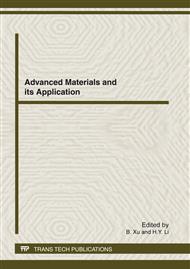p.70
p.74
p.78
p.82
p.86
p.90
p.94
p.98
p.103
Zirconate Conversion Coatings on Al Alloy by Electrochemical Method
Abstract:
Chromium-free conversion coatings were generated to replace chromate chemical process by electrolysis treatment LY12 aluminum alloy in zirconate solution. Film thickness, dropping test, the adhesion between aluminum and paint film were tested for single-factor experiments and orthogonal to seek better electrolysis process. The paint adhesion is the first grade for electrochemical conversion solution containing complexing agents, or it is the second grade without complexing agents. When DNS complexing agent is 2 ~ 5g/L, film corrosion resistance rises with the increasing content of complexing agent. If voltage is too low, corrosion resistance of conversion coating is poor; voltage is too high, the films form powders. Better formulations for zirconate conversion coating are: 5g/L DNS complexing agent, 10V voltage, treatment temperature is 40°C. Electrochemical conversion coating is thinner than chemical conversion, but the corrosion resistance is better because the electrochemical conversion coatings are smoother and compacter than the chemical conversion coating. The paint films on electrochemical conversion coating are smoother than the chemical one. Two kinds of conversion coatings have very good adhesion with paint film up to the first level. Electrochemical conversion coatings thickness is 2.5 μm, bubble time of NaOH-glycerine solution on them is up to 92s.
Info:
Periodical:
Pages:
86-89
Citation:
Online since:
February 2012
Authors:
Price:
Сopyright:
© 2012 Trans Tech Publications Ltd. All Rights Reserved
Share:
Citation:


